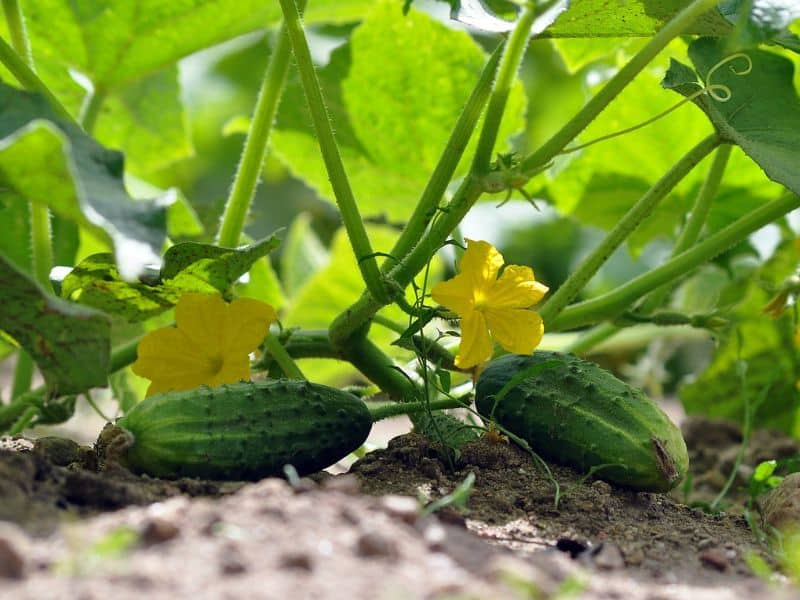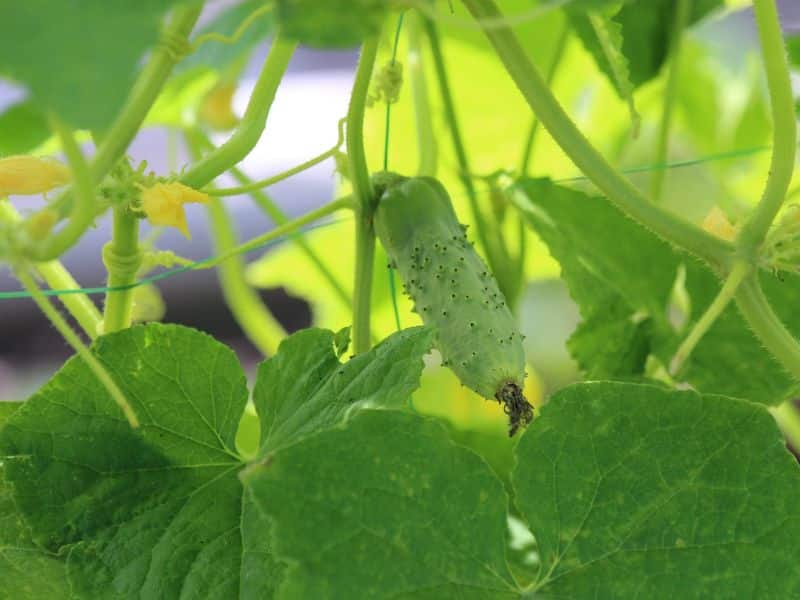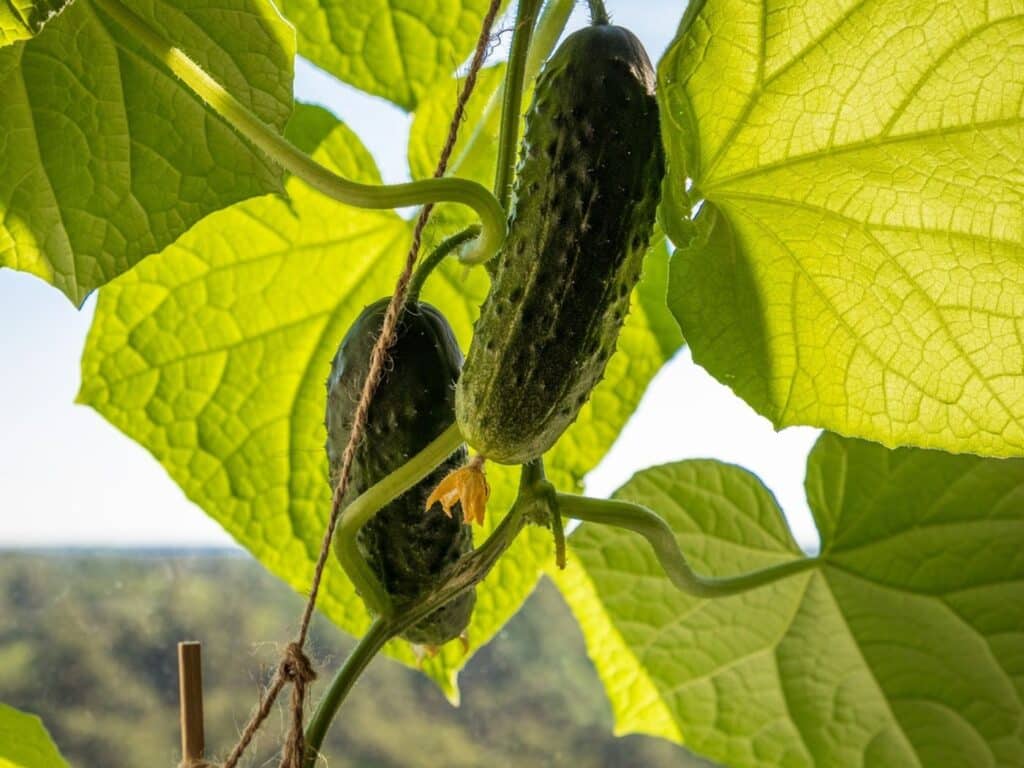Imagine stepping into your garden, expecting to see the lush green of your cucumber plants, but instead, you’re greeted by a sea of yellowing leaves. It’s disheartening, isn’t it?
Yellow leaves on cucumber plants are more than just an aesthetic issue; they signal that your plants are crying out for help. Whether you’re a seasoned gardener or a novice green thumb, encountering this problem can be puzzling and frustrating.
But don’t let worry take root. Understanding the underlying causes of yellowing leaves is the first step toward restoring the health and vitality of your cucumber plants.
This article will guide you through the potential reasons behind this common gardening challenge and offer practical solutions to get your cucumbers back to their vibrant selves. So, roll up your sleeves and prepare to give your plants the care they need to thrive.
Understanding Why Cucumber Leaves Turn Yellow
The Life Cycle of Cucumber Plants
Cucumber plants, like all living beings, go through a life cycle that can impact their appearance. Initially, seedlings burst through the soil, eager to soak up the sun.
During their growth, these plants undergo several stages, from developing true leaves to flowering and finally setting fruit. Yellowing leaves can sometimes be a sign of natural aging.
As cucumber plants mature, older leaves may well lose their vibrant green hue, turning yellow and then brown before falling off. This process is normal and indicates that the plant is focusing its energy on newer growth and fruit production.
Natural Causes of Yellowing Leaves
Not every yellow leaf signals doom and gloom for your cucumber plants. Sometimes, nature just likes to throw a curveball. Factors like changes in temperature, too much sunshine, or not enough can lead to yellowing leaves.
Similarly, water plays a crucial role – both overwatering and under-watering can stress your plants, causing leaves to yellow. This is the plant’s way of saying, “Hey, I’m not getting what I need.” By adjusting your watering schedule or providing some shade during the hottest part of the day, you can often turn things around.
Remember, yellowing leaves are your cucumber plant’s way of communicating with you. It’s your job to decode the message and provide the care it needs to thrive.
Common Factors Contributing to Yellowing

Nutrient Deficiencies
Yellow leaves on your cucumber plants often wave a flag about missing nutrients in the soil. Nitrogen, potassium, and magnesium shortages are the usual culprits.
A lack of nitrogen, for example, makes older leaves turn pale yellow. Potassium deficiency targets leaf edges first, yellowing them. And with magnesium, look for yellowing between leaf veins. A soil test reveals what’s missing, guiding you to the right fertilizer fix.
Remember, balance is key to avoid swapping one problem for another.
Watering Issues
Too much or too little water invites trouble, leading to yellow leaves. Cucumbers are thirsty plants but despise waterlogged roots. Overwatering suffocates them, mimicking drought stress symptoms.
On the flip side, underwatering puts them in survival mode, losing leaves to conserve water. The trick? Consistent moisture.
A mulch layer conserves water and keeps the soil evenly moist. Adjust your watering schedule with the weather; more during hot, dry spells and less when it’s cool or rainy.
Pests and Diseases
Pests and diseases love cucumber plants as much as you do, often causing leaves to yellow. Spider mites, tiny critters barely visible to the naked eye, suck plant juices, leading to yellow or bronzed leaves.
Cucumber mosaic virus, a more devious foe, spreads through aphid infestations, distorting and discoloring leaves. Vigilance is your best weapon. Inspect plants regularly and act fast at the first sign of trouble.
Removing affected leaves or using organic pesticides can avert a full-blown crisis. Remember, healthy plants resist pests and diseases better, so focus on creating a thriving garden environment.
Investigating the Problem

Examining Plant Symptoms
When your cucumber leaves start to adopt a yellow hue, it’s key to play the role of a plant detective. Check the leaves for any signs of pests, like the tiny webs of spider mites or the distinct markings left by the cucumber mosaic virus.
The pattern and location of yellowing can offer clues too; yellowing at the leaf edges or between veins points towards different issues. If the older leaves are yellowing while new ones seem healthy, it may well just be a sign of the plant prioritizing its new growth.
However, if yellowing is widespread, it signals a more serious concern that needs immediate attention.
Soil Testing for Clues
A soil test acts as a bridge between guesswork and knowing exactly what your cucumber plants need. If the yellowing leaves have led you here, then your soil may well be crying out for help.
Nutrient deficiencies or excess salts often manifest as yellow leaves. A soil test can reveal if your garden lacks essential elements like nitrogen, potassium, or magnesium. Armed with this knowledge, you can adjust your fertilization strategy in a precise manner, addressing the deficiency head-on and steering your cucumbers back towards vibrant health.
Preventative Measures and Solutions
Caring for cucumber plants goes beyond just watching them grow. It’s about taking proactive steps and making adjustments based on what those yellow leaves tell you. Let’s dive into specific actions you can take to keep your cucumber plants thriving.
Adjusting Watering Techniques
If your cucumber leaves are turning yellow, it may well be time to rethink your watering routine. Over-watering can drown roots and under-watering can stress plants, leading to yellow leaves. Aim for a balance.
Make sure your cucumbers get about 1 to 2 inches of water per week. Using a drip irrigation system or soaker hoses can provide a steady, controlled amount of water directly to the soil, reducing moisture on leaves and thus the risk of diseases.
Implementing Proper Fertilization
Yellow leaves can often signal a nutrient deficiency. A soil test can reveal exactly what your cucumber plants are missing. However, a general rule is to use a balanced fertilizer, something like a 10-10-10 (N-P-K) formulation, applied according to package directions.
Too much fertilizer can harm your cucumbers as much as too little, so apply carefully to avoid fertilizer burn which also causes yellowing of leaves.
Control of Pests and Diseases
Don’t let pests and diseases take your cucumber plants hostage. Regularly inspect the leaves, top, and bottom, for signs of pests like spider mites or diseases such as downy mildew. If you spot trouble, act fast.
Neem oil or insecticidal soaps can combat pests, and fungicides can address fungal issues. However, remember, prevention is key. Choose resistant cucumber varieties and practice crop rotation to minimize future problems.
By addressing watering, fertilization, and pest/disease control, you’re not just solving the yellow leaf problem. You’re enhancing the overall health and productivity of your cucumber plants.
Sometimes, it’s about the simple adjustments that make all the difference. Keep these tips in mind, and you’ll be on your way to a bountiful, healthy cucumber harvest.
When to Seek Professional Advice
If your DIY solutions and adjustments in watering, fertilization, and pest control don’t improve the yellow leaves on your cucumber plants, it’s time to call in the experts. Persistent issues may well indicate a more serious underlying problem that requires a specialist’s insight.
Contact a local agricultural extension office or a professional gardener if you notice no improvement after implementing the recommended strategies. They can offer targeted advice, perform soil tests not available to the general public, and identify specific diseases or pest infestations you may well have missed. Remember, catching and addressing these issues early can save your cucumber plants and your harvest.
Frequently Asked Questions
Why are my cucumber plant leaves turning yellow?
Yellowing of cucumber leaves can be caused by various factors including natural aging, environmental stress, nutrient deficiencies, over or under-watering, pests like spider mites, and diseases such as cucumber mosaic virus.
How can I prevent my cucumber plants’ leaves from yellowing?
Preventive measures include adjusting your watering techniques to avoid over or under-watering, ensuring proper fertilization with balanced nutrients, regularly inspecting for pests or diseases, and employing treatments if necessary.
When should I conduct soil testing for my cucumber plants?
Soil testing should be conducted if you observe yellowing leaves despite applying general care practices. It provides crucial information on soil nutrient levels and pH, allowing for accurate fertilizer adjustments.
What should I do if adjustments in watering and fertilization don’t improve the yellowing?
If your cucumber plants’ condition doesn’t improve after adjusting watering and fertilization, it’s advisable to seek professional advice from agricultural extension offices or professional gardeners for specialized guidance, soil tests, and disease or pest identification.
Can yellowing leaves be a sign of pest infestation or disease?
Yes, yellowing leaves on cucumber plants can indicate the presence of pests like spider mites or diseases such as cucumber mosaic virus. Regular inspection and timely intervention are crucial to manage these issues effectively.
See more: Lemon Tree Leaves Turning Yellow? Causes and Fixes







